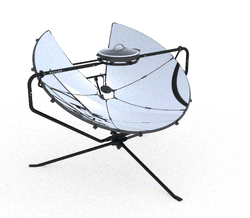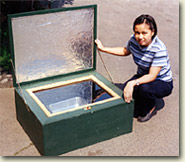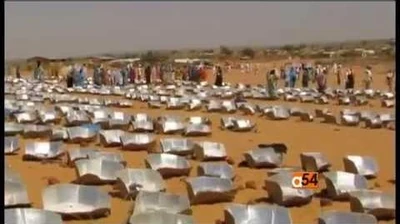Paul Hedrick (talk | contribs) Tag: sourceedit |
Tom Sponheim (talk | contribs) Tag: sourceedit |
||
| (24 intermediate revisions by 3 users not shown) | |||
| Line 1: | Line 1: | ||
{{GoogleTranslateLinks}} |
{{GoogleTranslateLinks}} |
||
| − | {{Updated| |
+ | {{Updated|11|1|15}} |
| + | <table cellspacing="2"> |
||
| + | <tr> |
||
| + | <td valign="top" width="45%">__TOC__</td> |
||
| + | <td valign="top" width="55%" style="padding:10px;"> |
||
| + | [[File:Yes_We_Do_Solar_Cook|400px|none]] |
||
| ⚫ | |||
| + | </table> |
||
__TOC__ |
__TOC__ |
||
Depending on [[Where is solar cooking possible?|where you live]] and how you cook, solar cooking can save you time, work, and fuel. It is also environmentally friendly, and a fun way to prepare your meals. All foods can be cooked in some type of solar cooker. |
Depending on [[Where is solar cooking possible?|where you live]] and how you cook, solar cooking can save you time, work, and fuel. It is also environmentally friendly, and a fun way to prepare your meals. All foods can be cooked in some type of solar cooker. |
||
| Line 6: | Line 13: | ||
Solar cooking is often associated with crockpot, or slow cooking. [[Guidelines and cooking tips|Cooking times]] for most solar cookers are typically twice that for conventional cooking methods. Slower cooking has its advantages however. Less water is used than with conventional cooking and foods retain more flavor and nutrients, rather than being steamed or boiled off. |
Solar cooking is often associated with crockpot, or slow cooking. [[Guidelines and cooking tips|Cooking times]] for most solar cookers are typically twice that for conventional cooking methods. Slower cooking has its advantages however. Less water is used than with conventional cooking and foods retain more flavor and nutrients, rather than being steamed or boiled off. |
||
| − | Basic solar cookers do not require stirring the food while cooking. By leading the sun orientation a little and adding a bit more cooking time, [[box cookers]] and [[Solar panel cookers|panel cookers]] can be set and left to cook unattended. [[Parabolic solar cooker]]s reach higher temperatures requiring more attention to the cooking food. They need to be reoriented to the sun approximately every fifteen minutes, which can be done automatically if they are equipped with a [[solar tracking]] device. |
+ | Basic solar cookers do not require stirring the food while cooking. By leading the sun orientation a little and adding a bit more cooking time, [[box cookers]] and [[Solar panel cookers|panel cookers]] can be set and left to cook unattended. [[Parabolic solar cooker]]s reach higher temperatures requiring more attention to the cooking food. They need to be reoriented to the sun approximately every fifteen minutes, which can be done automatically if they are equipped with a [[solar tracking]] device. They are also able to fry and broil foods, which box and panel cookers are unable to do. |
| − | For areas in the world experiencing [[deforestation]] and limited access to [[Water pasteurization|clean water]], solar cooking is proving to be a valuable [[Integrated Cooking Method|part of the solution]], by providing a safe [[Household air pollution|smoke-free]] alternative |
+ | For areas in the world experiencing [[deforestation]] and limited access to [[Water pasteurization|clean water]], solar cooking is proving to be a valuable [[Integrated Cooking Method|part of the solution]], by providing a safe [[Household air pollution|smoke-free]] alternative to cooking and boiling water over open fires. |
==Buy or build a solar cooker== |
==Buy or build a solar cooker== |
||
| − | [[ |
+ | [[Image:CooKit.jpg|right|thumb|275px||Solar Cookers International sells the [[CooKit]] solar panel cooker for $39.00 USD [http://shop.solarcookers.org/?pn=CooKit&cn=Cookers&p=621&c=27 online here].]] If you are interested in trying solar cooking for the first time, you may be wondering whether you should [[:Category:Solar cooker plans|build your own solar cooker]], or to [[:Category:Manufacturers and vendors|buy one from a manufacturer]]. There are advantages to both options: |
| + | #Building your own solar cooker can be a fun and cost-effective way to get started. |
||
| + | #Purchasing a solar cooker is simple and you will often receive a higher-quality cooker than one you could build yourself. |
||
| + | If you want to build a cooker, visit our [[:Category:Solar cooker plans|build a solar cooker]] page to choose a design that's right for you. You will find information comparing the [http://solarcooking.wikia.com/wiki/Category:Solar_cooker_plans#Selected_designs advantages and disadvantages] of each style of cooker. |
||
| + | |||
| + | If you would like to purchase a cooker, check out the list of manufacturers and vendors on our [[:Category:Manufacturers and vendors|buy a solar cooker]] page. Commercial cookers are typically durable and efficient, and offer an easy way for new users to experience solar cooking. As cookers are manufactured globally, consider potential shipping costs when selecting a design. |
||
==How do solar cookers work?== |
==How do solar cookers work?== |
||
| − | + | Solar cookers work on the basic principle: Sunlight is converted to heat energy that is retained for cooking. |
|
| − | The captured sunlight passes through a greenhouse enclosure enclosing a dark colored cook pot. As it hits the dark surface, the sunlight is converted to heat, which can not escape the enclosure, and cooking temperatures are achieved. |
+ | Most basic [[solar panel cookers]] and [[solar box cooker]]s can reach 120°C (250°F). The captured sunlight passes through a greenhouse enclosure enclosing a dark colored cook pot. As it hits the dark surface, the sunlight is converted to heat, which can not escape the enclosure, and cooking temperatures are achieved. This principle is often experienced by drivers returning to a closed car that has been parked in the sun. |
[[File:Solar_Cooking_basics,_SCI_2004,_pg._1,_12-9-14.png|none|500px]] |
[[File:Solar_Cooking_basics,_SCI_2004,_pg._1,_12-9-14.png|none|500px]] |
||
| Line 24: | Line 36: | ||
::[[File:SolSource_Solar_Stove_with_Cookware.gif|thumb|left|250px|[[SolSource]] is an example of a [[parabolic solar cooker]] shown with cookware. The light is focussed at the bottom of the cook pot.]] |
::[[File:SolSource_Solar_Stove_with_Cookware.gif|thumb|left|250px|[[SolSource]] is an example of a [[parabolic solar cooker]] shown with cookware. The light is focussed at the bottom of the cook pot.]] |
||
| − | [[File:Industrial_scale_cooking,_Solare_Brucke,_6-10-15.png|thumb|300px|[[Institutional solar cooking]] can employ many large [[parabolic solar cooker|parabolic]] reflectors |
+ | [[File:Industrial_scale_cooking,_Solare_Brucke,_6-10-15.png|thumb|300px|[[Institutional solar cooking]] can employ many large [[parabolic solar cooker|parabolic]] reflectors to generate steam, and cook for thousands of people daily. Many of these systems are in use in [[India]]. This example, was built with technology from [[Solare Brücke]].]] |
{{clr}} |
{{clr}} |
||
{{Main|How solar cookers work}} |
{{Main|How solar cookers work}} |
||
| Line 37: | Line 49: | ||
===<u>Panel cookers</u>=== |
===<u>Panel cookers</u>=== |
||
| − | [[ |
+ | [[File:CooKit_photo_Make.jpg|thumb|200px|[[CooKit]]]] |
Panel cookers incorporate elements of box and parabolic concentrator cookers. They are simple and relatively inexpensive to buy or produce. Solar Cookers International's "[[CooKit]]" is the most widely used combination cooker. |
Panel cookers incorporate elements of box and parabolic concentrator cookers. They are simple and relatively inexpensive to buy or produce. Solar Cookers International's "[[CooKit]]" is the most widely used combination cooker. |
||
{{Main|Solar panel cooker designs}} |
{{Main|Solar panel cooker designs}} |
||
| Line 76: | Line 88: | ||
*[[Emergency preparedness|Solar cooking and emergency preparedness]] |
*[[Emergency preparedness|Solar cooking and emergency preparedness]] |
||
*[[Promoting solar cooking]] |
*[[Promoting solar cooking]] |
||
| + | *[[Problems helped by solar cooking]] |
||
| − | *[[Q&A on Solar Cooking]] |
||
==Introductory manuals== |
==Introductory manuals== |
||
| Line 92: | Line 104: | ||
==Audio and video== |
==Audio and video== |
||
| + | *{{NewOct15}}'''June 2015:''' |
||
| ⚫ | |||
| + | ::[[File:Star Tides 4 Solar Cookers|thumb|none|400 px|Our last series on the [[STAR-TIDES]] expo in Washington, DC continues with technology available for emergency crisis and [[disaster relief]]. VOA’s Carolyn Turner talked with [[Solar Cookers International]] about their exhibit displaying how to cook with only the sun - ''Voice of America'']] |
||
==External links== |
==External links== |
||
| Line 98: | Line 111: | ||
* [http://www.isf-cameroun.org/sites/default/files/cookers_english_BD.pdf Construction of solar cookers and driers] - ''Christelle Souriau & David Amelin'' (This is an excellent overview of solar cooking basics and simple solar cooker and dryer construction methods.) |
* [http://www.isf-cameroun.org/sites/default/files/cookers_english_BD.pdf Construction of solar cookers and driers] - ''Christelle Souriau & David Amelin'' (This is an excellent overview of solar cooking basics and simple solar cooker and dryer construction methods.) |
||
*Three part series by Sharon Cousins on practical, humanitarian, and environmental aspects and potentials of solar cooking: [http://valeriecomer.com/?p=1113 Solar Cooking: Clean, Bright and Accessible], [http://valeriecomer.com/?p=1313 Out of the Smoke, Into the Sun], and [http://valeriecomer.com/?p=1438 Cleaner Cooking, Healthier Planet] |
*Three part series by Sharon Cousins on practical, humanitarian, and environmental aspects and potentials of solar cooking: [http://valeriecomer.com/?p=1113 Solar Cooking: Clean, Bright and Accessible], [http://valeriecomer.com/?p=1313 Out of the Smoke, Into the Sun], and [http://valeriecomer.com/?p=1438 Cleaner Cooking, Healthier Planet] |
||
| − | [[Category:Introduction to solar cooking]] |
||
Revision as of 20:28, 1 November 2015
|
Last edited: 1 November 2015
|
Depending on where you live and how you cook, solar cooking can save you time, work, and fuel. It is also environmentally friendly, and a fun way to prepare your meals. All foods can be cooked in some type of solar cooker.
Solar cooking is often associated with crockpot, or slow cooking. Cooking times for most solar cookers are typically twice that for conventional cooking methods. Slower cooking has its advantages however. Less water is used than with conventional cooking and foods retain more flavor and nutrients, rather than being steamed or boiled off.
Basic solar cookers do not require stirring the food while cooking. By leading the sun orientation a little and adding a bit more cooking time, box cookers and panel cookers can be set and left to cook unattended. Parabolic solar cookers reach higher temperatures requiring more attention to the cooking food. They need to be reoriented to the sun approximately every fifteen minutes, which can be done automatically if they are equipped with a solar tracking device. They are also able to fry and broil foods, which box and panel cookers are unable to do.
For areas in the world experiencing deforestation and limited access to clean water, solar cooking is proving to be a valuable part of the solution, by providing a safe smoke-free alternative to cooking and boiling water over open fires.
Buy or build a solar cooker
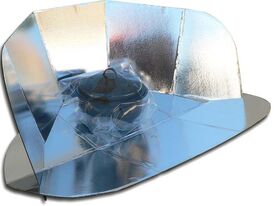
Solar Cookers International sells the CooKit solar panel cooker for $39.00 USD online here.
If you are interested in trying solar cooking for the first time, you may be wondering whether you should build your own solar cooker, or to buy one from a manufacturer. There are advantages to both options:
- Building your own solar cooker can be a fun and cost-effective way to get started.
- Purchasing a solar cooker is simple and you will often receive a higher-quality cooker than one you could build yourself.
If you want to build a cooker, visit our build a solar cooker page to choose a design that's right for you. You will find information comparing the advantages and disadvantages of each style of cooker.
If you would like to purchase a cooker, check out the list of manufacturers and vendors on our buy a solar cooker page. Commercial cookers are typically durable and efficient, and offer an easy way for new users to experience solar cooking. As cookers are manufactured globally, consider potential shipping costs when selecting a design.
How do solar cookers work?
Solar cookers work on the basic principle: Sunlight is converted to heat energy that is retained for cooking.
Most basic solar panel cookers and solar box cookers can reach 120°C (250°F). The captured sunlight passes through a greenhouse enclosure enclosing a dark colored cook pot. As it hits the dark surface, the sunlight is converted to heat, which can not escape the enclosure, and cooking temperatures are achieved. This principle is often experienced by drivers returning to a closed car that has been parked in the sun.
- Parabolic solar cookers use a bowl shaped reflector to focus the light more directly onto the cook pot, usually from below, and typically do not require a greenhouse enclosure to retain the heat. They reach much higher temperature than the other styles of solar cookers and have the ability to fry and broil foods.

SolSource is an example of a parabolic solar cooker shown with cookware. The light is focussed at the bottom of the cook pot.
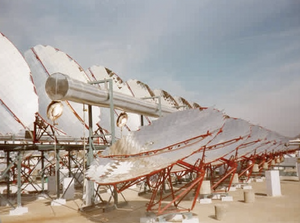
Institutional solar cooking can employ many large parabolic reflectors to generate steam, and cook for thousands of people daily. Many of these systems are in use in India. This example, was built with technology from Solare Brücke.
- Main article: How solar cookers work
Solar cooker types
The three most common types of solar cookers are box cookers, panel cookers, and parabolic solar cookers. Hundreds — if not thousands — of variations on these basic types exist. Additionally, several large-scale solar cooking systems have been developed to meet the needs of institutions worldwide.
Box cookers
Box cookers cook food at moderate to high temperatures and often accommodate multiple pots, typically taking between one and three hours to cook various foods. Worldwide, they are the most widespread. There are several hundred thousand in India alone.
- Main article: Solar box cooker designs
Panel cookers
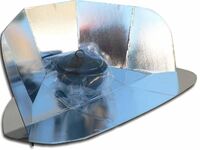
Panel cookers incorporate elements of box and parabolic concentrator cookers. They are simple and relatively inexpensive to buy or produce. Solar Cookers International's "CooKit" is the most widely used combination cooker.
- Main article: Solar panel cooker designs
Parabolic cookers
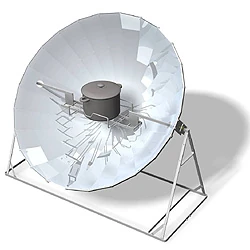
An AlSol 1.4 parabolic cooker demonstrates where the cook pot is supported to receive the focussed light from below from the reflector.
Parabolic solar cookers use a bowl shaped reflector to focus the light more directly onto the cook pot, usually from below, and typically do not require a greenhouse enclosure to retain the heat. The parabolic name refers to the shape of the curve of the reflector cross-section.
They will require more frequent reorientation to the sun, possibly every fifteen minutes, but they cook food more quickly at higher temperatures compared to other solar cookers, often reaching over 200°C (400°F). They also have the ability to fry and broil foods. Generally parabolic solar cookers will need to be attended to more than box or panel cookers to avoid possibly burning the food at the bottom of the cook pot. They are especially useful for large-scale institutional solar cooking systems.
- Main article: Parabolic solar cooker designs
More information on pots, glazing enclosures, and reflective material, used to gather additional sunlight.
Cooking with your solar cooker
The golden rule for solar cooking is get your food on early, and do not worry about overcooking. Most people starting to solar cook will be using a solar panel cooker or solar box cooker. These cookers are oriented to the sun and typically don't need to be turned to follow the sun during a 3-4 hour cooking period. Add much less water to the recipe than you would use cooking with more conventional stoves and ovens.
Once you have decided on a cooker, you will need to find appropriate cookware. Thin-walled dark enameled metal cook pots work well. They are good at heating up quickly. Cast iron pots also work, and are typically preheated in the solar cooker before cooking. The advantage of the heavier pots is that they will help maintain an even cooking temperature if the sun is occasionally blocked by clouds, but most solar cooks seem to use the enamel pots. Because dark cooking pots work the best in solar cookers, it is important to remember to use a nontoxic paint for the exterior cook pot surface if you choose to darken your own pots.
- Main article: Guidelines and cooking tips
Introductory articles
- Solar cooking frequently-asked questions
- How solar cookers work
- Solar cooking tips and tricks
- Recipes
- Cooking guidelines
- Solar cookbooks
- Where is solar cooking possible?
- The case for solar cooking
- Build a solar cooker
- Buy a solar cooker
- Health and safety
Learn more
- Why solar cooking is important
- Most significant solar cooking projects
- United Nations Millennium Development Goals
- The history of solar cooking
- Solar cooking and emergency preparedness
- Promoting solar cooking
- Problems helped by solar cooking
Introductory manuals
- Solar Cookers: How to Make, Use, and Enjoy (There are also detailed versions in Arabic (Standard, Variation), French, Spanish, and English for Kenya, and Galician.)
- Construction of solar cookers and driers - Christelle Souriau & David Amelin (This is an excellent overview of solar cooking basics and simple solar cooker and dryer construction methods.)

Solar orientation, Construction of solar cookers and driers, Souriau & Amelin
Audio and video
- June 2015:
Star Tides 4 Solar Cookers
Our last series on the STAR-TIDES expo in Washington, DC continues with technology available for emergency crisis and disaster relief. VOA’s Carolyn Turner talked with Solar Cookers International about their exhibit displaying how to cook with only the sun - Voice of America
External links
- The Expanding World of Solar Box Cookers - Barbara Kerr (This is the full-text of the book by this solar cooking pioneer)
- Construction of solar cookers and driers - Christelle Souriau & David Amelin (This is an excellent overview of solar cooking basics and simple solar cooker and dryer construction methods.)
- Three part series by Sharon Cousins on practical, humanitarian, and environmental aspects and potentials of solar cooking: Solar Cooking: Clean, Bright and Accessible, Out of the Smoke, Into the Sun, and Cleaner Cooking, Healthier Planet





